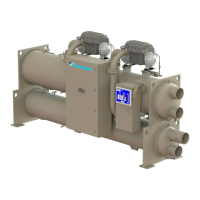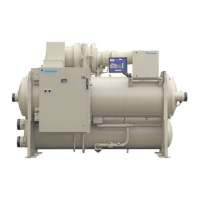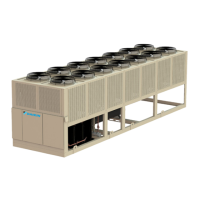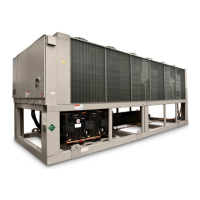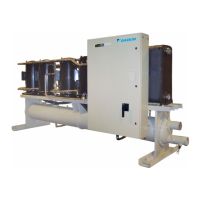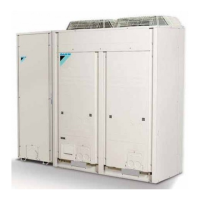57
IOM 1264-4
WWW.DAIKINAPPLIED.COM
MAINTENANCE
charge has been contaminated, the charge should be recovered
and tested for contaminates or noncondensables. Appropriate
actions should be taken based on testing and Clean Air Act
regulations.
Vibration Monitoring (Optional)
Vibration readings are often used as an indicator of a possible
problem requiring maintenance. If vibration monitoring is part
of the site PM program, the compressor can be checked with a
vibration analyzer on an annual basis. When doing the annual
testing, the load should be maintained as closely as possible
to the load of the original test. The initial vibration analysis test
provides a benchmark of the compressor, and when performed
routinely, can give a warning of impending problems.
Lubrication
POE type oil is used for compressor lubrication. This type of
oil is extremely hygroscopic which means it will quickly absorb
moisture if exposed to air and form acids that can be harmful
to the chiller. Avoid prolonged exposure of refrigerant to the
atmosphere to prevent this problem.
CAUTION
POE oil must be handled carefully using proper protective
equipment (gloves, eye protection, etc.). The oil must not come
into contact with certain polymers (e.g. PVC) as it may absorb
moisture from this material. Also, do not use oil or refrigerant
additives to the system.
WARNING
Polyolester Oil, commonly known as POE oil is a synthetic oil
used in many refrigeration systems, and is present in this Daikin
Applied product. POE oil, if ever in contact with PVC/CPVC, will
coat the inside wall of PVC/CPVC pipe causing environmental
stress fractures. Although there is no PVC/CPVC piping in this
product, please keep this in mind when selecting piping materials
for your application, as system failure and property damage
could result. Refer to the pipe manufacturer’s recommendations
to determine suitable applications of the pipe.
It is important that only the manufacturer’s recommended oil be
used. Acceptable POE oil types are:
• Emkarate RL 220H
• Icematic S68A ( R-513A)
Oil charges given in Table 32 are guidelines only. The unit is
properly charged with oil when the oil level is between the upper
and lower sight glasses while the unit is running at full capacity.
The lower sightglass is used to ensure there is a minimum
amount of charge in the unit for running.
Figure 40: Sight Glasses - Condenser
Table 32: Oil Charge Guideline
Unit Conguration
Compressor/Evaporator/Condenser Oil Charge (gal)
JNNS/E1610/C1810 6.5
JNNS/E1610/C2010 6.5
MNNS/E1610/C1810 6.5
MNNS/E1610/C2010 7.5
MNNS/E2010/C2010 7.5
MNNS/E2410/C2410 7.5
RNNS/E2010/C2010 7.5
RNNS/E2410/C2410 7.5
Oil Filter Removal and Renewal
Prior to this procedure, pump out the compressor. Isolate the
electrical supply to the control panels and compressor motor
terminal. Filter should be changed when pressure drop delta
goes above the linear line in Figure 41.
Figure 41: Pressure Drop to Change Oil Filter
y = 0.3846x + 10.596
0
10
20
30
40
50
60
70
80
90
100
0 50 100 150 200 250
Oil Pressure Difference = Condenser Pressure - Oil
Pressure (PSIG)
Operating Pressure Difference = Condenser Pressure - Evaporator Pressure (PSIG)
Recommended Filter
Delta P Change
Linear (Oil Filter
Pressure Drop)
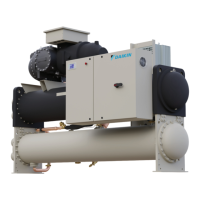
